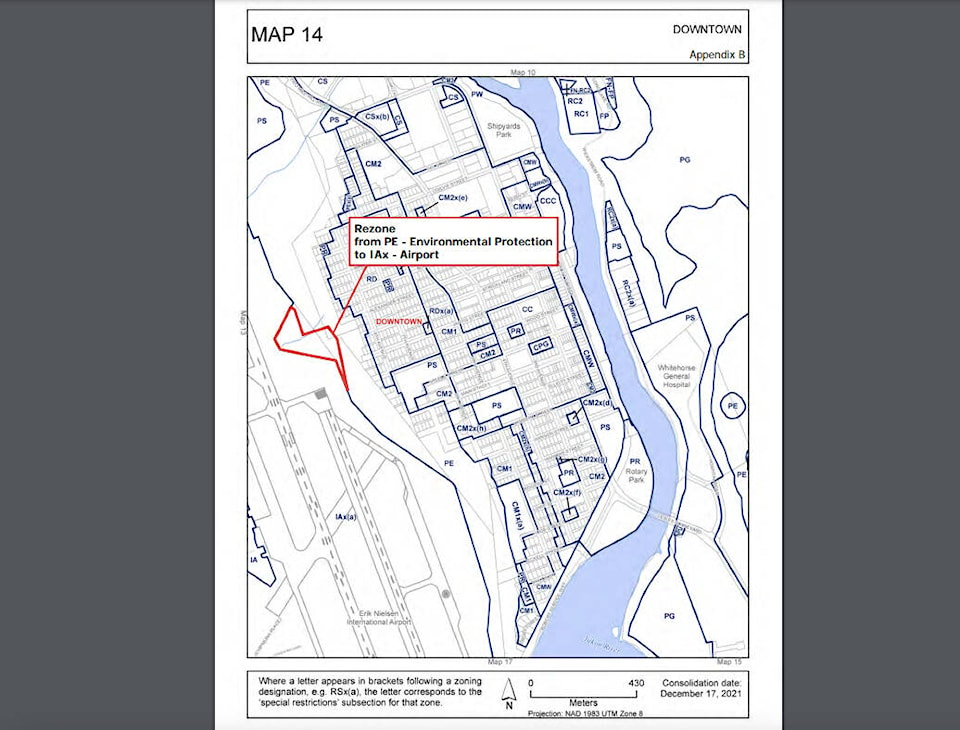The Yukon government will host a public information session outlining its airport runway expansion plans at the Erik Nielsen Whitehorse International Airport in Whitehorse and the impacts to trails and a protected area in the vicinity.
Whitehorse Mayor Laura Cabott highlighted the planned meeting during city council’s discussion about the proposed rezoning for land in the Puckett’s Gulch area. The rezoning would see land zoned as environmental protection altered to an airport designation as the territory looks to expand a runway by 150 meters to meet Transport Canada regulations. The airport is currently operating the runway with an exemption, but it’s anticipated the larger runway will be needed for 737 traffic as passenger volumes return to pre-pandemic levels.
The plans will see a portion of the airport trail rerouted, as well as a fence, roadway and manhole moved to make way for the runway.
When the matter initially came up for discussion at the Aug. 1 meeting, council members contemplated having the territory host a meeting about the plans ahead of the city’s public hearing.
City council can call on a proponent to host such meetings when they are seeking a rezoning, but only after first reading.
As Cabott explained after the Aug. 1 meeting, she received a letter from Highways and Public Works Minister Nils Clarke who committed to the public information session ahead of any public hearing.
“In that letter Mr. Clark advises the topics of the information session will include impacts to the Black Street stairs, impacts to the main airport trail and perimeter walking trail, as well as an overview of the geotechnical assessments for Puckett’s Gulch, timelines and scope of work for infilling Puckett’s Gulch and relocating the airport fence,” Cabott said. “That will be occurring again sometime before Monday, Sept. 12. We don’t have a date yet, but I’m sure once the Yukon government has determined that, they will share that with the public.”
Sept. 12 was set as the date for the public hearing, provided first reading of the rezoning bylaw passed, as it did at the Aug. 8 meeting.
Before voting in favour of the first reading, Coun. Mellisa Murray was quick to note the territory held public engagement sessions about the airport plans in 2021, receiving feedback from just 11 residents.
“So I do want to encourage people to come to the [next] information session as it is a pretty big deal,” she said. “I think a lot of people use that area for active transportation and a lot of members of the community are worried about the escarpment as well.”
Escarpment slides in the spring and early summer closed off a large portion of Robert Service Way and areas around the clay cliffs downtown for a lengthy period. Those were also highlighted as a concern by city staff, who noted geotechnical studies, surface drainage, escarpment stability and construction plans will have to be completed as part of the process for the runway expansion given the airport’s location at the top of the escarpment above the downtown.
Coun. Kirk Cameron has cited concerns about the area as a wildlife corridor. At the April 8 meeting, he continued to voice concerns over the environmental impact, although he noted he’s encouraged by the information session the government has committed to.
“It sounds to me like there’s going to be a robust debate and discussion around this very important piece of business,” he said.
With first reading passed, the territory will host its information session ahead of the city’s public hearing at the Sept. 12 council meeting.
A report will then come forward to council Oct. 3, with the final two readings for the rezoning Oct. 11.
Should the rezoning be adopted, a lengthy process for the city land to then be transferred to the territory would begin with an amendment to the downtown escarpment land use policy to reflect the zoning change. Disposition, subdivision and the formal land transfer would follow, including the development agreement.
Contact Stephanie Waddell at stephanie.waddell@yukon-news.com
